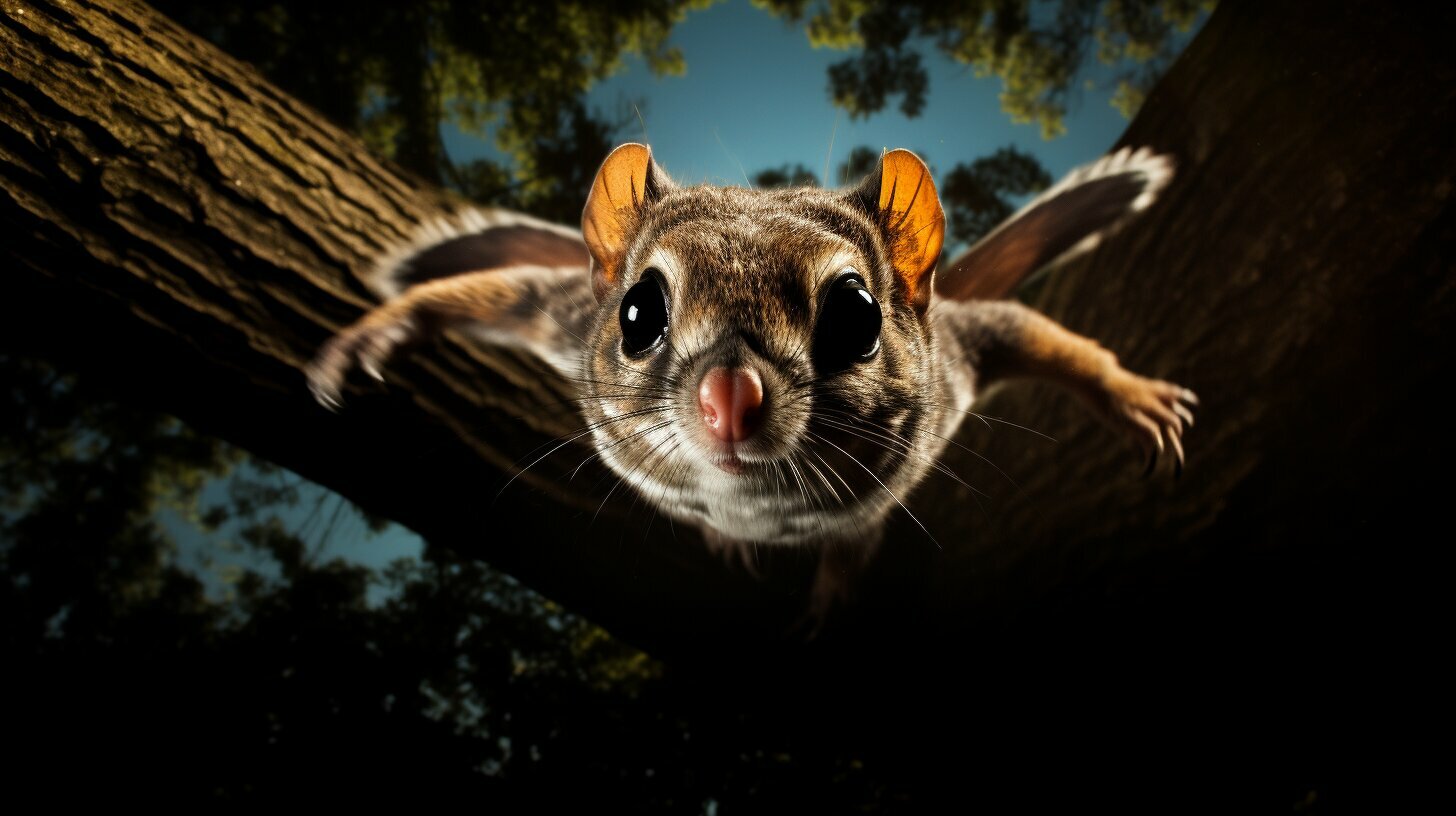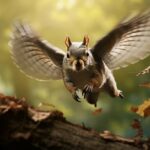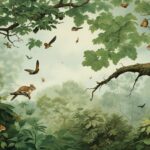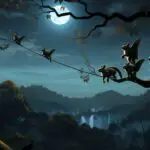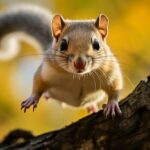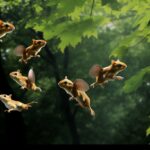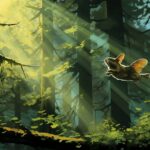Flying squirrels are remarkable creatures that have adapted in extraordinary ways to their surroundings. These fascinating mammals are known for their gliding abilities, enabled by their specialized membrane of skin called a patagium. This stretchy membrane stretches between their limbs, allowing them to glide through the air with ease. While they can’t actually fly, some species of flying squirrels can glide impressive distances of up to 450 meters.
With over 50 known species found across the world, flying squirrels display a diverse range of adaptations. Primarily nocturnal animals, they have large eyes that provide them with better vision in low-light conditions. This allows them to navigate their forested habitats with precision. Flying squirrels are excellent gliders, capable of reaching speeds of up to 20 miles per hour.
In addition to their gliding abilities, flying squirrels have adapted to a varied diet. They consume a wide range of foods, including fruits, nuts, seeds, insects, and even bird eggs. This flexibility in their diet helps them thrive in different environments and maximize their chances of survival. Social animals, flying squirrels communicate with each other through vocalizations, scent marking, and body language.
When it comes to landing, flying squirrels have a unique adaptation in the form of a cartilaginous extension called a patagial spur. This structure helps them stabilize and control their descent, ensuring a safe landing after a glide. By dispersing seeds as they move through their forest habitats, flying squirrels play a crucial role in maintaining healthy ecosystems.
Despite their exceptional adaptations, flying squirrels have relatively short lifespans ranging from 4 to 6 years in the wild. Nonetheless, their ability to adapt to their environment in such extraordinary ways allows them to thrive in their habitats and contribute to the balance of nature.
Key Takeaways:
- Flying squirrels have a specialized membrane called a patagium that allows them to glide through the air.
- They are primarily nocturnal and have large eyes for better vision in low-light conditions.
- Flying squirrels can reach speeds of up to 20 miles per hour while gliding.
- They have a diverse diet that includes fruits, nuts, seeds, insects, and bird eggs.
- By dispersing seeds, flying squirrels play a crucial role in maintaining healthy forest ecosystems.
Understanding Flying Squirrel Behavior and Habitat
Flying squirrels are primarily nocturnal animals that inhabit various regions around the world. These fascinating creatures have adapted to their environment in unique ways, allowing them to thrive in their habitats.
One of the key behavioral traits of flying squirrels is their nocturnal nature. They are most active during the night, utilizing their excellent night vision to navigate through the darkness. This behavior helps them avoid potential predators and hunt for food without competition from diurnal species. Their large eyes, which are optimized for low-light conditions, further enhance their ability to see in the dark.
Flying squirrels prefer forested areas as their natural habitat. These environments provide them with the necessary resources for survival, such as food and shelter. Forested habitats offer an abundance of trees, which serve as their primary means of transportation. These agile creatures are excellent climbers, capable of effortlessly scaling tree trunks and leaping from branch to branch. The dense canopy of trees also provides them with ample cover, helping them avoid detection from predators.
Flying squirrels excel in gliding from tree to tree, utilizing their unique adaptation: the patagium. This specialized membrane of skin stretches between their limbs, allowing them to glide through the air with precision. Their gliding abilities enable them to cover vast distances and access food sources that are otherwise inaccessible. This behavior, combined with their preference for forested habitats, ensures their survival and contributes to the overall health of the ecosystem.
| Key Points | Flying Squirrel Behavior | Flying Squirrel Habitat |
|---|---|---|
| Nocturnal Nature | Flying squirrels are nocturnal creatures, most active during the night. | They prefer forested habitats with an abundance of trees for cover and food. |
| Excellent Night Vision | Their large eyes provide them with superior vision in low-light conditions. | Forested areas offer ample cover and resources for their survival. |
| Patagium Adaptation | Their specialized membrane of skin allows them to glide through the air. | Their preference for forests provides them with optimal gliding routes. |
The Evolution and Characteristics of Flying Squirrels
Over millions of years, flying squirrels have evolved distinct characteristics that set them apart from other squirrel species. These remarkable creatures have developed unique adaptations that allow them to glide effortlessly through the air, making them true acrobats of the forest.
One of the most notable features of flying squirrels is their patagium, a stretchy membrane of skin that extends between their limbs. This patagium acts like a parachute, allowing them to catch air currents and glide for long distances. It is a remarkable adaptation that enables them to navigate through the forest canopy and access food sources that many other animals cannot reach.
In addition to their gliding abilities, flying squirrels possess other characteristics that contribute to their survival. Their large eyes provide excellent vision in low-light conditions, allowing them to navigate and forage during their nocturnal lifestyle. Their diverse diet of fruits, nuts, seeds, insects, and even bird eggs ensures they have a varied food source, increasing their chances of survival in their natural habitat.
Furthermore, flying squirrels exhibit social behaviors that contribute to their success as a species. They communicate with each other through vocalizations, scent marking, and body language, enabling them to establish and maintain social bonds within their communities. These social interactions also aid in their survival by helping them coordinate activities such as foraging and predator detection.
All of these evolutionary adaptations and characteristics work together to make flying squirrels highly efficient and successful creatures in their natural environment. They play a vital role in seed dispersal and contribute to the overall health of forest ecosystems. Let’s appreciate the wonders of nature and marvel at the incredible evolution of these fascinating animals.
Unveiling the Flying Squirrel Diet and Anatomy
Flying squirrels have a diverse diet that includes fruits, nuts, seeds, insects, and even bird eggs, enabling them to adapt to different food sources.
Their nimble foraging abilities allow them to navigate through the forest canopy in search of these varied food items. The flying squirrel’s anatomy plays a crucial role in their dietary habits. They have sharp incisors for cracking open nuts, strong jaws for breaking through tough outer layers of fruits, and agile paws for capturing insects.
One fascinating aspect of their anatomy is their specialized patagium, a membrane of skin that stretches from their front to hind limbs. This patagium not only enables them to glide through the air but also helps them reach food sources in treetops that are otherwise inaccessible to ground-dwelling squirrels. It acts as a parachute, allowing these squirrels to navigate effortlessly from tree to tree.
| Food Group | Examples |
|---|---|
| Fruits | Apples, berries, figs |
| Nuts | Acorns, walnuts, hazelnuts |
| Seeds | Sunflower seeds, pinecones |
| Insects | Beetles, caterpillars, ants |
| Bird eggs | Small songbird eggs |
These food sources provide flying squirrels with the necessary nutrients for their survival and reproduction. Their varied diet also makes them important contributors to seed dispersal in forest ecosystems, as they consume fruits and nuts and then distribute the undigested seeds throughout their habitat.
The Locomotion and Conservation of Flying Squirrels
Flying squirrels are excellent gliders, capable of reaching impressive speeds and playing a crucial role in seed dispersal and ecosystem maintenance. With their specialized skin membrane called a patagium, these remarkable creatures can effortlessly glide through the air, utilizing the power of wind currents to navigate and travel vast distances. Although they don’t possess the ability to fly, their gliding capabilities are truly impressive, with some species able to cover distances of up to 450 meters.
These agile mammals are found worldwide, with over 50 known species inhabiting diverse regions across the globe. They primarily inhabit forested areas, where they can find plentiful food sources and suitable tree cavities for nesting. Flying squirrels are primarily nocturnal creatures, adapting their behavior to thrive under the cover of darkness. Their large eyes provide enhanced vision in low-light conditions, allowing them to spot prey and navigate through the trees with ease.
Species Diversity and Habitat Conservation
The various species of flying squirrels have adapted to a wide range of environments, from temperate forests to tropical rainforests. Each species has unique characteristics and adaptations that enable them to survive and thrive in their specific habitats. For example, the Northern flying squirrel (Glaucomys sabrinus) is well-suited to colder climates, while the Southern flying squirrel (Glaucomys volans) is found in the southeastern United States and has adaptations for warmer environments.
Conservation efforts are vital to protect the natural habitats of flying squirrels and ensure their continued existence. Deforestation and habitat loss pose significant threats to these species, as they rely on the availability of trees for nesting, food sources, and safe gliding routes. By preserving and restoring their natural habitats, we can help maintain the delicate balance of forest ecosystems and safeguard the future of these fascinating creatures.
| Flying Squirrel Species | Location | Habitat |
|---|---|---|
| Northern flying squirrel | North America | Coniferous and mixed forests |
| Southern flying squirrel | Southeastern United States | Deciduous and mixed forests |
| Red giant flying squirrel | South and Southeast Asia | Tropical and subtropical forests |
| Malayan flying squirrel | Southeast Asia | Tropical rainforests |
Flying squirrels are not only fascinating creatures to study and admire but also crucial contributors to the health and biodiversity of forest ecosystems. By understanding their locomotion abilities and conserving their natural habitats, we can ensure a brighter future for these remarkable gliding mammals.
In Conclusion, the Marvels of Flying Squirrel Adaptation
Flying squirrels have truly fascinating adaptations that enable them to thrive in their habitats, serving as a testament to the wonders of nature’s ingenuity. These remarkable creatures are known for their gliding abilities, thanks to a specialized membrane of skin called a patagium. This unique feature stretches between their limbs, allowing them to gracefully glide through the air. While they may not have the ability to fly, some species of flying squirrels can glide impressive distances of up to 450 meters.
With over 50 known species found in various regions across the world, flying squirrels exhibit a diverse range of behaviors and adaptations. They are primarily nocturnal animals, relying on their large eyes for enhanced vision in low-light conditions. This allows them to navigate through their forested habitats with ease, avoiding obstacles and finding their preferred food sources.
The diet of flying squirrels is also quite diverse, consisting of fruits, nuts, seeds, insects, and even bird eggs. Their adaptability in food choices contributes to their survival in different environments. Along with their gliding abilities, flying squirrels communicate through vocalizations, scent marking, and body language, establishing strong social bonds within their communities.
One fascinating aspect of their adaptation for landing is the presence of a cartilaginous extension called a patagial spur. This unique structure helps flying squirrels stabilize and control their descent, ensuring a safe landing after each glide. As seed dispersers, these creatures play a crucial role in maintaining healthy forest ecosystems, as they help propagate tree species through their foraging activities.
Although flying squirrels have relatively shorter lifespans, ranging from 4 to 6 years in the wild, their ability to adapt to their environment in distinct ways is a true marvel. Their remarkable adaptations, from gliding abilities to specialized anatomy and social behaviors, make them a fascinating group of mammals to study and appreciate. Nature’s ingenuity shines through these creatures, highlighting the inherent wonders of the animal kingdom.
Can You Explain the Hibernation Habits of Flying Squirrels?
Flying squirrels and hibernation in nature are intertwined in fascinating ways. These small mammals possess the ability to hibernate during winter when food becomes scarce. Unlike other squirrels, they do not store food. Instead, they rely on their body fat reserves and nest in tree cavities to withstand the cold. During this period, their metabolic rate decreases, enabling them to conserve energy. This remarkable adaptation allows flying squirrels to survive harsh winters and emerge in spring, ready to resume their active lifestyle.
FAQ
Q: How far can flying squirrels glide?
A: Although they don’t actually fly, some species of flying squirrels can glide up to 450 meters.
Q: How many species of flying squirrels are there?
A: There are over 50 known species of flying squirrels found in various regions across the world.
Q: What do flying squirrels eat?
A: Flying squirrels have a diverse diet that includes fruits, nuts, seeds, insects, and even bird eggs.
Q: How fast can flying squirrels glide?
A: Flying squirrels can reach speeds of up to 20 miles per hour while gliding.
Q: How do flying squirrels communicate?
A: Flying squirrels communicate with each other through vocalizations, scent marking, and body language.
Q: How long do flying squirrels live?
A: Flying squirrels typically have shorter lifespans compared to other squirrel species, ranging from 4 to 6 years in the wild.
Q: What role do flying squirrels play in the ecosystem?
A: Flying squirrels play a crucial role in seed dispersal and help maintain healthy forest ecosystems.

